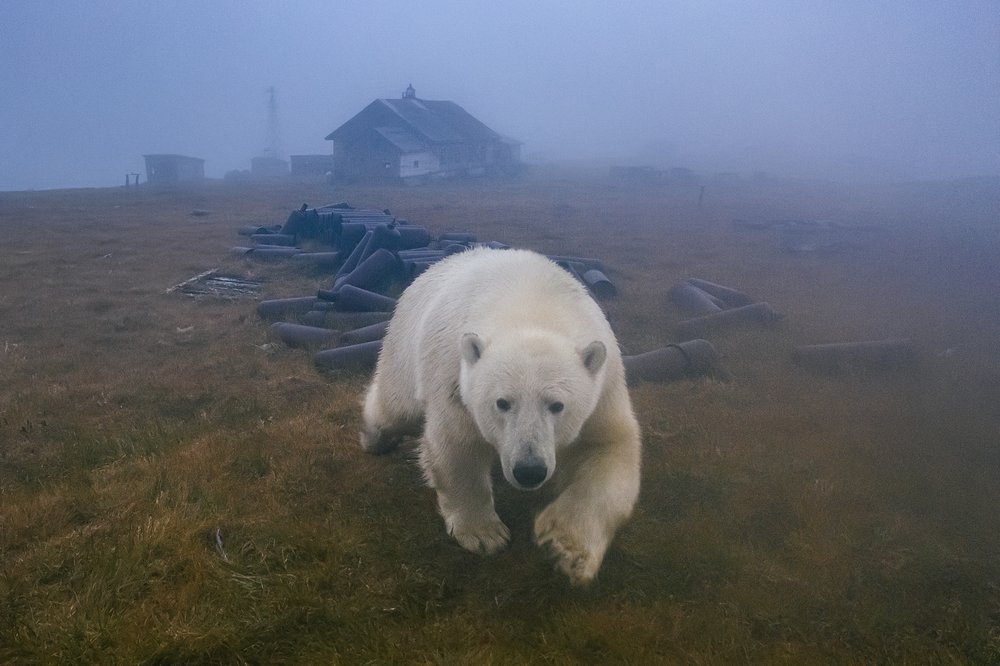Admiration: today’s images of polar bears taking over an abandoned weather station have gone viral in the last few weeks. Wildlife photographer Dmitry Kokh traveled by boat to Kolyuchin Island, Chukotka, Russia, last year and photographed the giants (gentle they are not,) likely with drones. There was something that captured me on so many levels
– the beauty of the photographs themselves.
– the underlying disquietude that bears are driven ever further into human habitat due to melting ice from climate change.
– the spirited approach to photography that involves traveling along hazardous routes.

I went to his website and saw stern requests not to publish without permission. Sent him an email and had a positive response within 48 hours. Grateful! Спасибо!
Here is a short video of the bears moving about. I urge you to look also at Kokh’s grey heron images which he took in Russia during the 2020 pandemic lockdown. They are stunning.

Amusement: As with all things that deservedly go viral on the Internet, there is a spirited approach to creating memes that mark the occasion. In the case of the polar bear house invasion, you now find AirBnB ratings that pretend to have traveled to this remote spot in the Chukchi Sea.



Awe: and talking about spirited approaches – few are more mind-boggling than those of Joel Berger, a scientist at the Department of Fish, Wildlife, and Conservation Biology, Colorado State University. Berger’s goal is “problem solving to achieve actionable conservation.” In his own words:
“Science is but one of many avenues to achieve this. Although policy change can be a goal, so can be altering attitudes, inspiring others, or solving mysteries. My own work tends to be with species larger than a bread box, and thematically on issues concerning population ecology, thermal ecology, effects of people on species as landscapes change, migration, and climate stressors. Understanding how we’ve altered food webs is also important. Much of my efforts continue to be in remote ecosystems, although there are clear advantages to work on biodiversity issues in the mountains and deserts of the Intermountain West.”

Cold-adapted species have held a special place in his research, and here the polar bear theme re-emerges. The scientist, in his quest to understand the impact of stressors like climate degradation and extreme icing events on muskoxen, the largest Arctic mammal, actually donned a polar bear costume to approach the herds in the wild. The 7-year longitudinal study with observations in both the Western and Eastern Arctic revealed, as expected, not exactly good news. Here is a video of Berger in action as a polar bear.

If I were, say, 40 years younger, I’d apply to be a research assistant. Why? Just look at the locations where he is involved: Northern Rocky Mountains and deserts to the west, the Arctic in both Asia (Wrangel Island, Chukotka, Russia) and Alaska, and some areas within central or high elevation Asia – Mongolia, China (Tibet), and Bhutan. And the questions he and his teams are asking:

In the meantime, I’ll read scientific news on polar bears….

Instead of music today here are the sounds of the arctic, and an Inuit poem contemplating the everlasting ice and scientific research affecting the region. It is a video (28 minutes) best watched when in a meditative space.







Nicky
WOW !!!!
Maryellen Read
WONDERFUL
Betsy Quinn
Why is that photo of the two polar bears looking out from the broken window frame of the deserted weather station somewhere in northern Russia so unbearable, haunting and sad?